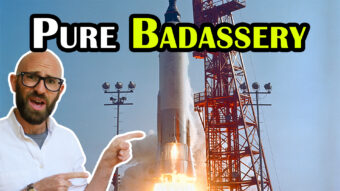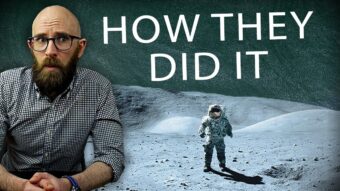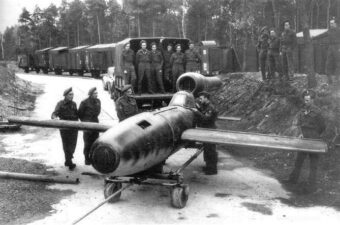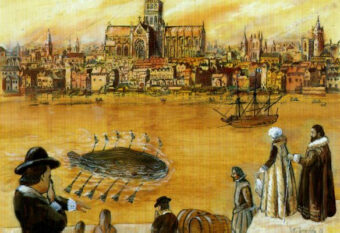
Leroy Gordon Cooper Jr. is probably best remembered for his portrayal by actor Dennis Quaid in the 1983 film The Right Stuff. In the film, Cooper is portrayed as a cocky fighter jock with an easy smile and the catchphrase “Who’s the best pilot you ever saw? Well, you’re looking at him.” However, the real Coope was considerably more soft-spoken and taciturn than his Hollywood counterpart. Born on March 6, 1927, in Shawnee, Oklahoma, Cooper first learned to fly in his father’s biplane, soloing at age 12 and earning his pilot’s license at 16. As the Army and Navy flying schools were no longer taking candidates, Cooper instead joined the Marine Corps, but WWII ended before he could see active service. After living in Hawaii where he met his first wife Trudy Olson, Cooper finally received military flight training at Williams Air Fire Base in Arizona and in 1950 was posted to Landstuhl Air Base, West Germany. In 1956, Cooper attended the US Air Force Experimental Test Pilot School at Edwards Air Force Base in California and spent the next three years test-flying high-performance jet aircraft.
In February 1959 Cooper was invited to participate in the gruelling medical tests to select America’s first astronauts. While he passed with flying colours, one obstacle stood in his way: his marriage. While Cooper claimed to NASA officials that he was in a stable, happy marriage, in fact Trudy had left him four months before on account of his infidelity, a rather common trend among many of these early astronauts- see the video on our sister channel TodayIFoundOut- Don Draper in a Spacesuit- The Life of Alan Shepard, but nonetheless keeping up appearances was critical. Knowing that NASA wanted to project an image of its astronauts as dependable family men, Cooper convinced Trudy to come back and keep up the charade that they were a happily married couple. With this detail sorted, Cooper passed selection. At 32, he was the youngest of the Mercury Seven.
Cooper would serve as capsule communicator for Alan Shepard’s 1961 Mercury-Redstone 3 flight and Scott Carpenter’s 1962 Mercury-Atlas 7 mission, and as backup pilot for Wally Schirra on Mercury-Atlas 8 before finally getting his chance to fly in May of 1963. Mercury-Atlas 9 was a highly ambitious flight that would see Cooper orbit the earth for an entire day – more than three times the duration of any previous mission – and push the capabilities of the Mercury spacecraft to their absolute limits. And it was a mission that very nearly didn’t happen. The previous Mercury-Atlas 8 flight had been a near-textbook mission, and many believed that NASA should end the Mercury program on a high note and move on to the more sophisticated Project Gemini. However, as all but one of the Soviet Vostok manned flights had lasted a day or more, it was decided to fly one last mission to bring the American program up to par with the Russians.
To prepare it for its marathon mission, Cooper’s Mercury Capsule, which he dubbed Faith Seven, underwent extensive modifications, including the addition of extra batteries and oxygen tanks and the removal of equipment such as the periscope to save weight. A number of scientific experiments were also planned for the flight, including the installation of a bungee cord so Cooper could exercise in orbit. Cooper was also provided with experimental freeze-dried foods to try out, which could be rehydrated using the capsule’s onboard water tank. Other experiments included testing a slow-scan TV camera, taking photographs of the Earth’s airglow layer and zodiacal light, observing a bright spotlight in South Africa, deploying a small sphere with flashing lights to test visual tracking, measuring radiation levels in orbit, and deploying a small tethered balloon to measure atmospheric drag.
The launch date for Mercury-Atlas 9 was set for May 14, 1963. But Cooper very nearly wasn’t the pilot. Two days earlier, while flying an F-106 Delta Dart, Cooper had recklessly buzzed a building where senior NASA officials were meeting. The stunt so enraged Mercury Operations Director Walt Williams that he nearly pulled Cooper off the flight in favour of his backup pilot, Alan Shepard. Nevertheless at 6:36 AM on the 14th, Cooper rode the elevator up the gantry and climbed aboard the capsule only to find an amusing gift had been left for him: a toilet plunger with a tag reading “Remove Before Flight.” It was a prank by Shepard, who, lacking any sort of urine collection system on his flight, had been forced to urinate in his spacesuit- yes the first American in space, and second human overall, did so soaking in his own urine. Unfortunately, radar problems at the Bermuda tracking station lead to the launch being scrubbed, but the next morning at 8:04 AM, Mercury-Atlas 9 roared off the pad and streaked into the sky, Cooper exclaiming: “What an afterburner!” Orbital insertion was perfect, and an hour and a half later as Faith 7 passed over Guaymas, Mexico, Mission Control announced Cooper was go for at least seven orbits.
For the first eighteen orbits, Mercury-Atlas 9 seemed like it would be another textbook mission. Indeed, the flight surgeons were astonished by how little oxygen Cooper consumed during the flight, a consequence of him being the only member of the Mercury Seven who didn’t smoke. The only major problem Cooper encountered was regulating the temperature of his space suit, an issue that had also plagued previous Mercury missions. Cooper also had difficulty transferring water into his dehydrated food packets, and reported that some of the selections, including powdered roast beef mush, were less than palatable. But with the exception of the test balloon failing to deploy, Cooper managed to carry out all his assigned experiments without incident. On his tenth orbit, Cooper also became the first astronaut to sleep in orbit, dozing heavily for around an hour before waking up over the Himalayas. On his 15th orbit, Cooper recited a prayer into his onboard voice recorder:
“I would like to take this time to say a little prayer for all the people, including myself, involved in this launch and this operation. Father, thank you, for the success we have had in flying this flight. Thank you for the privilege of being able to be in this position, to be up in this wondrous place, seeing all these many startling, wondrous things that you’ve created.”
But 29 hours into the flight, at the start of Cooper’s 19th orbit, signs began to appear that all was not well. As Faith 7 approached Hawaii, the 0.5g indicator light on Cooper’s instrument panel suddenly lit up. This light normally indicated that the spacecraft had entered the earth’s atmosphere and was beginning to decelerate, but as Cooper’s orbit was holding true, Ground Control suspected that the switch had been tripped by a short circuit. This suspicion was confirmed an hour later when Cooper reported that his Automatic Stabilization and Control System, or ASCS, was not responding. A system of gyroscopes that allowed the astronaut to determine his orientation, the ASCS was essential for aligning the spacecraft for reentry. But no matter what Cooper or Ground Control tried, they could not revive the system, and it was soon discovered that the 250-volt inverter bus bar had suffered a catastrophic short circuit, permanently knocking out the ASCS. Faith 7 was now drifting passively, unable to control its orientation.
Back on the ground, Mission Control swung into crisis mode. The textbook mission had suddenly turned into a nightmare. While the Mercury Capsule was designed to be controlled from the ground in case the astronaut was incapacitated, in this case the ground controllers were just as blind as Cooper; without the ASCS to tell them the spacecraft’s orientation, neither could align the capsule for retrofire. Ironically, this eventuality had actually been accounted for in the Mercury Capsule’s original design. The periscope, which was deleted from Faith 7 to save weight, featured a system that allowed the astronaut to use the earth’s horizon to line up the capsule for reentry. This alignment was absolutely crucial; if the capsule entered the atmosphere at too steep an angle, it would burn up; too shallow, and it would skip off the atmosphere and become stranded in orbit, condemning the astronaut to a slow death by suffocation.
But just as it seemed like the last Mercury mission would end in tragedy, Cooper performed one of the most extraordinary feats of piloting in spaceflight history. On his 22nd orbit, exactly 34 hours after liftoff, Cooper fired Faith 7’s retro-rockets and flew the spacecraft manually through reentry, using grease-pencil lines drawn on the capsule window to align himself with the stars and his wristwatch to time the duration of the burn. It was an extraordinarily risky maneuver, for even if Cooper survived the reentry, every second he was off in his timing would cause him to overshoot the recovery area by many miles. But incredibly, Cooper’s manual reentry was so perfect that he splashed down only four and a half miles from the recovery aircraft carrier USS Kearsarge – the closest landing of all the Mercury flights. He had flown better than any NASA computer, proving once and for all the value of pilots in spaceflight and dispelling the notion that the Mercury astronauts were, in the words of test pilot Chuck Yeager, merely “spam in a can.”
Prior to Cooper’s flight, Alan Shepard had petitioned to fly an even longer three-day, 48-orbit mission, but due to the numerous technical issues which had plagued Mercury-Atlas 9, it was decided that the Mercury Capsule design had been pushed far enough, and the program was brought to a close. Cooper would be the last American to fly into orbit alone.
Cooper immediately transitioned to Project Gemini, which would test all the equipment and skills needed for the upcoming Apollo lunar missions. In 1965, Cooper was given command of Gemini 5, whose primary objective was to demonstrate the feasibility of an eight-day flight – the minimum time needed to fly to and from the moon. It was on this mission that Cooper created what would become an enduring NASA tradition: the custom mission patch. Cooper’s design featured the names of the crew along with a drawing of a covered wagon bearing the slogan “Eight Days or Bust.” On August 21, 1965, Cooper and co-pilot Pete Conrad blasted off from Cape Canaveral and spent a relatively uneventful eight days in orbit, during which they finally smashed the Soviet space endurance record of 4 days, 23 hours set by Vostok 5 in 1963.
But Gemini 5 would be Cooper’s last hurrah as an astronaut. In the buildup to the mission, Cooper had displayed a lax attitude towards training, believing his natural piloting skills to be an ample substitute for simulator practice. This attitude did little to endear him to fellow Mercury astronaut Deke Slayton, who as head of the Astronaut Office was responsible for choosing crew assignments. Cooper and Slayton’s relationship further soured when Cooper entered the 1968 24 Hours of Dayton auto race, and complained loudly to the press when NASA forced him to withdraw. Nonetheless, Slayton placed Cooper on the backup crew for Apollo 10. According to NASA’s crew rotation system this would have placed Cooper in command of Apollo 13, and Slayton hoped the assignment would whip Cooper into shape. However, in May 1969 Alan Shepard, after undergoing corrective surgery for an inner ear condition called Meniere’s Disease, returned to flight status and replaced Cooper as commander of Apollo 13. Shepard’s command was later moved to Apollo 14 to give him more time to train. This decision outraged Cooper, who felt that Shepard, who had a mere 15 minutes of suborbital spaceflight experience under his belt, was unqualified to command an Apollo mission. Realizing that he was unlikely to ever fly again, Cooper resigned from NASA on July 31, 1971.
After leaving NASA, Cooper worked as a technical consultant for a number of aerospace and technology firms, including General Motors and Walt Disney – where he served as vice president of research and development for Epcot. He also founded his own aerospace consulting and land development firm, Gordon Cooper & Associates, and became heavily involved in high-speed boat racing and underwater archaeology. Cooper also became increasingly obsessed with UFOs, which he claimed to have seen many times over his test-flying career. So convinced was he that the U.S. Government was covering up the presence of extraterrestrials that he even testified on the subject to the United Nations in 1978. Leroy Gordon Cooper died of heart failure on October 4, 2004 – the 47th anniversary of the launch of Sputnik – at the age of 77. While his conduct during Projects Gemini and Apollo and his later UFO obsession lost him a certain measure of respect among his peers, few would deny that on that glorious day of April 16, 1963, Cooper had truly been the greatest pilot anyone had ever seen.
If you liked this article, you might also enjoy our new popular podcast, The BrainFood Show (iTunes, Spotify, Google Play Music, Feed), as well as:
- How Do Astronauts Go to the Bathroom in Space?
- What Happens if You Commit a Crime in Space?
- NASA and Their Real Life Space DJ’s
- The Final Frontier Part 2: How Astronauts Go to the Bathroom in Space and How Women Can Safely Pee Standing Up
Bonus Facts
#1 The Mercury Seven were well known to be a boisterous bunch fond of practical jokes, which ranged from Alan Shepard’s toilet plunger gag to an infamous incident where the astronauts dropped a motor boat and a cooler of live fish into the pool of Florida’s Starlite Motel and proceeded to have a fishing party. But one of the Mercury Seven’s favourite games involved a tongue-in-cheek fraternal organization started by WWII pilots known as the Ancient and Honorable Order of Turtles – AKA the “Turtle Club.” The rules of the game were simple. If one member of the order asked another “Are you a turtle?” the latter had to answer “You bet your sweet ass I am!” Failure to deliver the correct password would result in the victim having to buy a round of drinks. This private game came close to being made public during the October 3, 1962 Mercury-Atlas 8 mission, when Deke Slayton, acting as Capsule Communicator, asked pilot Wally Schirra “Are you a turtle today?” Knowing that his transmissions were being broadcast live to the nation, Schirra simply said “Roger” and switched to his onboard voice recorder to deliver the appropriate answer. In official NASA mission transcripts, his reply is simply given as “Correct response recorded.” Schirra would later get his revenge as Commander of Apollo 7, when he asked the same question of Deke Slayton and NASA public affairs officer Paul Haney, both of which failed to give the correct response and, presumably, owed Schirra a drink when he returned to earth.
#2: A long-standing NASA tradition is for astronauts to eat a breakfast of steak and eggs just prior to a launch. This practice, which originated all the way back with Alan Shepard’s 1961 Mercury-Redstone 3 flight, actually had a practical purpose. In addition to being high in protein, steak and eggs are almost completely absorbed by the body and leave very little residue in the digestive tract. As the early astronauts did not have any provision for collecting fecal matter in their space suits, such a “low-residue” diet was an ideal means of avoiding close encounters of the turd kind. Not that it exactly worked on longer missions, see our video on TOdayIFoundOut- To Boldly Go Where No Fecal Matter Has Gone Before
Expand for ReferencesMA-9 Mission Transcript: https://ia800607.us.archive.org/28/items/NasaAudioHighlightReels/MA09_TE2.pdf
The Flight of Faith 7, 1963, https://archive.org/details/flight_of_faith_7
Garber, Megan, 2060 Minutes: Gordo Cooper and the Last American Solo Flight in Space, The Atlantic, May 17, 2013, https://www.theatlantic.com/technology/archive/2013/05/2-060-minutes-gordo-cooper-and-the-last-american-solo-flight-in-space/275988/
Burgess, Colin, Selecting the Mercury Seven: The Search for America’s First Astronauts, Springer-Praxis Books, 2011
Carpenter, M. Scott et al, We Seven, Simon and Schuster, 1962
Evans, Ben, The Right Man: Remembering Gordon Cooper’s Day-Long Mercury Mission, 55 Years On, AmericaSpace, May 13, 2018, https://www.americaspace.com/2018/05/13/the-right-man-remembering-gordon-coopers-day-long-mercury-mission-55-years-on/
Gray, Tara, L. Gordon Cooper, Jr. NASA, https://history.nasa.gov/40thmerc7/cooper.htm
The post I’ll Do It Myself- The Greatest Feat of Piloting in Space appeared first on Today I Found Out.



0 comments:
Post a Comment
Please ,
Don't enter span link